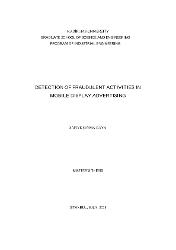| dc.contributor.advisor | Çavdaroğlu, Burak | en_US |
| dc.contributor.author | Kaya, Safiye Şeyma | |
| dc.date.accessioned | 2019-07-12T08:38:31Z | en_US |
| dc.date.available | 2019-07-12T08:38:31Z | en_US |
| dc.date.issued | 2017 | en_US |
| dc.identifier.uri | https://hdl.handle.net/20.500.12469/2243 | |
| dc.description.abstract | Most of the marketing expenditures in mobile advertising are conducted through realtime bidding (RTB) marketplaces in which ad spaces of the sellers (publishers) are auctioned for the impression of the buyers’ (advertisers) mobile apps. One of the most popular cost models in RTB marketplaces is cost per install (CPi). in a CPi campaign publishers place mobile ads of the highest bidders in their mobile apps and are paid by advertisers only if the advertised app is installed by a user. CPi cost model causes some publishers to conduct some infamous fraudulent activities known as click spamming and click injection. A click spamming publisher executes clicks for lots of users who haven’t made them. if one of these users hears about the advertised app organically (say via TV commercial) and installs it this installation will be attributed to the click spamming publisher. in click injection the fraudulent publisher’s spy app monitors the user’s activities in the app market to detect when a mobile app is downloaded on her device and triggers a click attributed to the fraudster right before the installation completes. in this study we propose a novel multiple testing procedure which can identify click spamming and click injection activities using the data of click-to-install time (CTiT) the time difference between the click of a mobile app’s ad and the first launch of the app after the installation. in a sample set of publishers we show that our procedure has a falsepositive error rate of at most 5%. Finally we run an experiment with 15263 publishers. According to the results of the experiment a total of 1474 fraudulent publishers are successfully detected. | en_US |
| dc.description.abstract | Mobil reklamcılıkta pazarlama harcamalarının çoğu gerçek zamanlı ihaleler aracılığı ile gerçekleştirilmektedir. Gerçek zamanlı ihalelerde, satıcıların (reklam yayınlayıcılarının) reklam alanları, alıcıların (reklam verenlerin) mobil uygulamalarına ait reklamlarının kullanıcı tarafından görüntülenebilmesi için ihaleye çıkartılır. Gerçek zamanlı ihalelerde en çok kullanılan fiyatlandırma modeli indirme başına fiyatlandırmadır. Bu modelde en yüksek fiyatı veren reklam verenin uygulaması yayınlayıcının uygulamasında gösterilir. Yayınlayıcıya ödeme bir kullanıcının bu yayınlanan reklamı tıklayarak indirmesi şartıyla yapılır. Bu model bazı yayınlayıcıların tıklama bombardımanı (click spamming) ve tıklama enjeksiyonu (click injection) olarak bilinen sahtekâr aktivitelerde bulunmasına neden olur. Tıklama bombardımanında yayınlayıcı gerçekte kullanıcı tarafından yapılmamış birçok tıklama üretir. Bu durumdan habersiz olan kullanıcı, reklamı yapılan uygulamayı farklı bir reklam kanalı (televizyon reklamı gibi) aracılığı ile öğrenip indirirse tıklama bombardımanını yapan yayınlayıcı bu indirmeden haksız yollarla para kazanmış olur. Tıklama enjeksiyonunda ise sahtekâr bir uygulamayı indirmek üzere olan bir kullanıcıyı takip edip, indirmeyi tamamlamadan hemen önce o kullanıcı üzerinden reklama tıklama gönderebilir. Dolayısıyla da bu indirme işlemi üzerinden haksız kazanç elde etmiş olur. Bu çalışmada çoklu test etme yöntemini kullanarak bu sahtekârlıkların belirlenebileceği bir yöntem önerdik. Bu yöntemde indirme ve ilk kez uygulamanın açılması arasında geçen zaman üzerinden istatistiksel karar verme yöntemleri kullanılarak sahtekârlar tespit edilmeye çalışıldı. Kullanılan yöntemde yanlış pozitif hata oranının en kötü ihtimalle %5 olması sağlandı. Önerilen yöntem 15263 yayınlayıcının üzerinde test edildi ve 1474 tanesinin sahtekârlık yaptığı tespit edildi. | en_US |
| dc.language.iso | eng | en_US |
| dc.publisher | Kadir Has Üniversitesi | en_US |
| dc.rights | info:eu-repo/semantics/openAccess | en_US |
| dc.subject | Mobile advertising | en_US |
| dc.subject | Fraud Detection | en_US |
| dc.subject | Click Spamming | en_US |
| dc.subject | Click Injection | en_US |
| dc.subject | Multiple Testing | en_US |
| dc.subject | Mobil Reklamcılık | en_US |
| dc.subject | Sahtekârlık Tespiti | en_US |
| dc.subject | Tıklama Bombardımanı | en_US |
| dc.subject | Tıklama Enjeksiyonu | en_US |
| dc.subject | Çoklu Test Etme | en_US |
| dc.title | Detection of fraudulent activities in mobile display advertising | en_US |
| dc.type | masterThesis | en_US |
| dc.department | Enstitüler, Lisansüstü Eğitim Enstitüsü, Endüstri Mühendisliği Ana Bilim Dalı | en_US |
| dc.relation.publicationcategory | Tez | en_US |
| dc.identifier.yoktezid | 519811 | en_US |
















